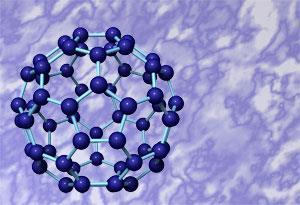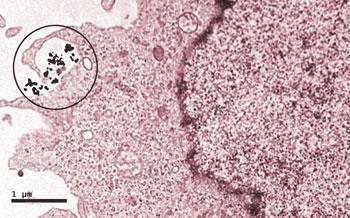Will there ever be a major nanotechnology health scare? Researchers are investigating the potential risks posed by nanoparticles in a bid to pre-empt any health scares that could prove fatal to the industry. Jon Evans reports
Will there ever be a major nanotechnology health scare? Researchers are investigating the potential risks posed by nanoparticles in a bid to pre-empt any health scares that could prove fatal to the industry. Jon Evans reports
The spectre of genetically modified (GM) crops is hanging ominously over the nanotechnology sector. Around 10 years ago, the UK life science company Zeneca launched one of the first GM food products - a tomato paste made from genetically modified tomatoes - and received a generally positive response. But within a few years, fears over the possible health and environmental risks of GM crops turned the public against the technology and destroyed the market, at least in Europe.
Although GM crops, and the foods derived from them, have been accepted much more readily in other regions of the world, this experience shows the damage that can be inflicted on a new technology by public fears, even if they are largely unfounded.

Nanotechnology is now at a similar stage in its commercial development, with the first nanotechnology-based products, most of which contain various types of nanoparticle, having recently reached the market. The Project for Emerging Nanotechnologies, a US body exploring the implications of nanotechnology, estimates that over 200 commercial nanotechnology products have now been launched. These include sun lotions containing titanium dioxide nanoparticles to help scatter the sun’s rays, plasters containing silver nanoparticles to kill bacteria, and tennis and squash rackets containing carbon nanotubes (CNTs) to enhance their strength.
But these products are just the tip of the iceberg. Over the coming decade, a whole range of more advanced nanotechnology-based products should reach the market, including biosensors, fuel cells, self-cleaning surfaces and thermally-insulated windows. Nanotechnology will also help to improve the performance of numerous existing products, including rechargeable batteries, electronic circuits, computer memories and solar cells.
This should fuel tremendous growth in the market for nanotechnology-based products. This market is already fairly substantial - worth around $32 billion (about ?18 billion) in 2005, according to the Project for Emerging Nanotechnologies - but the US National Science Foundation (NSF) predicts that it will be worth $1000 billion by 2015.
Despite this optimism, nanotechnology researchers realise that the commercial development of nanotechnology could be seriously, and perhaps permanently, derailed by any kind of health scare. This has spurred a number of researchers to begin investigating the potential risks of nanotechnology, in order to find ways to mitigate these risks and pre-empt any public fears.
According to Andrew Maynard, chief science adviser with the Project on Emerging Nanotechnologies, these investigations and the debate over their findings are taking place at an unusually early stage in the development cycle. At least compared with other controversial technologies, such as GM crops and nuclear power. Nevertheless, they are probably happening not a moment too soon, as highlighted earlier this year when the nanotechnology sector experienced its first health scare.
This involved a German bathroom cleaning product known as Magic Nano, which works by forming wafer-thin films that block minor crevices in surfaces, preventing dirt and bacteria from building up. It was launched at the end of March 2006 and withdrawn three days later after 80 people reported respiratory problems and six were admitted to hospital. Initially, it was thought that nanoparticles in the cleaner might have caused these health problems.
Subsequent investigations revealed that the product didn’t actually contain any nanoparticles (under 100nm in diameter) and suggested that the health problems were more likely caused by the propellant used in the product. Nevertheless, this was a shot over the bows for the nanotechnology sector and emphasised how little is known about the effects of nanoparticles.
It is the same unique properties that make nanoparticles interesting from a science and technology perspective that also make them a cause for concern; because of their tiny size, nanoparticles behave very differently from bulk materials. They have a large comparative surface area, which means that a greater proportion of molecules are displayed on the particle surface and are available to take part in reactions, and are small enough to be influenced by quantum effects.
These properties create difficulties when trying to predict any toxicological effects of nanoparticles, because you cannot assume that they will behave in the same way as the bulk form of the material.
The only way to identify potential health or environmental risks is to conduct specific toxicological tests on the nanoparticles.
Kicking the buckyball

One of the first researchers to conduct tests of this kind was Eva Oberd?rster, an environmental toxicologist at Southern Methodist University in Dallas, Texas, US. In 2003, she exposed nine largemouth bass to a water-soluble form of the famous buckyball, a C60 spherical molecule.
She discovered that, after only 48 hours, the fish displayed signs of brain damage, as measured by the oxidation of lipids in brain tissue samples. This brain damage occurred at levels 17 times higher than seen in fish not exposed to buckyballs. The exposed fish also displayed altered gene expression and the onset of inflammation in their livers.
The water-soluble C60 molecules used by Oberd?rster were developed by Vicki Colvin, a professor of chemistry and chemical engineering at Rice University, Houston, US, and director of its Center for Biological and Environmental Nanotechnology. Buckyballs aren’t naturally water soluble, but Colvin found that upon contact with water they group together into soluble agglomerates between 25 and 500 nanometres in diameter, which she called nano-C60.
The fact that buckyballs can exist in this water-soluble form and can cause damage to biological tissue indicates that they at least have the potential to become environmental pollutants. This possibility has led Colvin, over the past few years, to explore some of the implications of Oberd?rster’s findings.
In 2004, she discovered that buckyballs could be made less toxic by modifying their surfaces. She and her colleagues exposed human cells to four different types of buckyball: one had no modifications, while the other three had different molecules, such as hydroxide ions, attached to their surfaces. They discovered that the unmodified buckyballs caused substantially more damage to the human cells than the modified versions.
In addition, she discovered that the buckyballs produced their toxic effects by generating oxygen radicals, which then went on to damage the cell membranes.
Other researchers have failed to find any evidence of buckyball toxicity, while some have reported that the molecules can actually soak up free radicals. For instance, in 2005 a team of researchers led by Fathi Moussa from the Universit? Paris XI, France, reported that aqueous C60 suspensions protected rat livers from the damage caused by free radicals.
Indeed, a US nanomedicine company called C Sixty, a wholly owned subsidiary of Carbon Nanotechnologies, US, is developing a novel antioxidant drug based on buckyballs and their ability to soak up free radicals. The company claims that its buckyball-based drug should be able to treat a wide range of diseases that involve tissue damage, including Alzheimer’s disease, multiple sclerosis, and possibly even the physical effects of ageing.
Although somewhat of a poster boy for nanotechnology, buckyballs have not yet found any widespread commercial applications and so any research into their potential toxicity currently has few practical implications. However, it has spurred on researchers to investigate the nanoparticles that are beginning to be used in products such as CNTs.
In 2005, Colvin and her colleagues found that water soluble single-walled CNTs were far less toxic than buckyballs, and that adding molecules to their surface reduced their toxicity still further.
But other researchers have reported that both single-walled and multi-walled CNTs are able to generate oxygen radicals and cause damage to various human cell types.
The situation is further complicated by a recent study by a team from the Institute of Toxicology and Genetics at the Karlsruhe Research Center, Germany, which suggests that standard cell viability tests used in CNT work can produce false toxicity results. The methylthiazol tetrazolium (MTT) test measures how the salt is converted to a purple dye called formazan.
The Karlsruhe researchers, led by Harald Krug, suggest that MTT in fact reacts with nanotubes, causing them to clump together. This would make the formazan undetectable and the nanotubes appear toxic. ’We think our work demonstrates that standards should be established when testing the toxicity of carbon nanotubes and other nanomaterials,’ says Krug.
Radical oxygen
Titanium dioxide nanoparticles have also been found to generate oxygen radicals in bodily tissue. Nanosize titanium dioxide is used in air and water remediation and in numerous products designed for human use and consumption.
In 2006, a team of researchers led by Bellina Veronesi from the US Environmental Protection Agency (EPA) found that exposing a type of immune system cell known as microglia to titanium dioxide nanoparticles caused the rapid and sustained production of oxygen radicals.
According to Andre Nel, professor of medicine at the University of California, Los Angeles, US, and director of the university’s nanotoxicology research training programme, this increase in the production of oxygen radicals is probably the best explanation for the possible toxic effects of nanoparticles.
Oxygen radicals are produced in the body by the natural workings of the cell and as part of the body’s defence mechanism. Mitochrondria, which are the energy-generating structures in cells, regularly produce oxygen radicals as a byproduct of their activity.
In addition, certain immune system cells, including microglia, produce oxygen radicals to destroy unwanted invaders, in a process known as ’oxidative burst’. Usually, these oxygen radicals are contained or mopped up by the body, but nanoparticles seem to stimulate their production, leading to tissue damage.

She and her team are now exploring the implications of these findings. ’We are examining whether there are neurotoxic consequences to that release by examining the effects of titania on cultured neurones,’ she says. ’We will examine this response in isolated neurones and those cultured in the presence of microglia and other brain cells.’
The fact that Veronesi is an EPA researcher is an interesting development, because it indicates that government agencies are beginning to take the potential health risks of nanotechnology more seriously. This is important, because most of the studies that have been conducted so far have been done in relative isolation from each other, with no consistent approach. This probably explains why different research groups have come up with such varied and contradictory findings.
In contrast, government agencies should be able to organise and fund longer term research programmes to come up with more definitive answers on the health and environmental risks of nanotechnology. Nevertheless, this interest is fairly recent and there are concerns about whether the agencies are willing to spend enough money. ’Many agencies are talking about [nanotoxicology issues], but there is no coordinated action and funding is just starting to emerge,’ says Nel.
As Veronesi points out, her work for the EPA is still at a very early stage. ’We are in the initial stages of examining potential neurotoxicity,’ she says. ’Predicting effects on animals or humans would require an extremely lengthy course of testing, involving successively more complicated experimental models.’
As is clear, there is still no consensus on the potential risks of nanotechnology and many researchers are uneasy about reports of health scares. ’Clearly nanoparticles may cause some health problems - the harmful effects of pollution are likely to relate, in part, to the significant levels of nanoparticles to which we are exposed all the time,’ says Milo Shaffer, a reader in nanomaterials at Imperial College, London. ’On the other hand, I’m wary of people claiming that nanotechnology in general presents particularly unique or unusual health concerns. I think that is potentially misleading.’
Money spinning
Maynard claims that US government agencies have been spending around $11 million a year on nanotoxicology research (although the agencies increased this to almost $40 million in 2006). He recently called for the spend to rise to $100 million over the next two years and proposed a comprehensive framework for exploring the possible risks. ’Without such an approach, significant knowledge gaps - which currently exist in all areas of nanotechnology risk assessment - will persist,’ he claimed.
Sensibly, US government agencies appear initially to be funding basic research into nanotoxicology and into developing standardised ways to measure the toxicity of nanoparticles. For instance, the EPA is funding work by Nel to develop a new testing method, based on the generation of oxygen radicals, to assess the health risks of nanomaterials.
The agencies are also encouraging more multidisciplinary research. For instance, the NSF is funding research at Brown University, Rhode Island, US, into the development of a novel chip-based platform for testing the toxicology of different nanoparticles. ’What makes [this] effort interesting, in my opinion, is that it is an equal effort by material scientists and toxicologists to find out not only if nanomaterials are toxic but why, and what materials scientists can do about it in terms of synthesis, purification and post-processing,’ says Robert Hurt, professor of engineering at Brown University.
Regulatory agencies in other areas of the world also appear to be getting more interested in the topic. The European Union recently funded two research programmes into the health risks of nanotechnology, with a joint budget of over €1 million (?680,000), which involved universities and research institutes throughout Europe.
In the UK, in response to the recommendations in a 2004 report produced by the Royal Society and the Royal Academy of Engineering, the government has set out a programme of research objectives to characterise the potential risks posed by nanoparticles. It has set aside
over ?10 million to fund this programme.
Research into nanotechnology does appear to gathering pace. Providing this research stays ahead of any health scares, the nanotechnology sector should eventually be able to banish the spectre of GM crops.
Jon Evans is a science writer based in Chichester, UK.
Further Reading
- T C Long et al, Env. Sci. Technol., 2006, 40, 4346
- Nanotechnology: consequences for human health and the environment. Eds: R Hester and
R M Harrison, RSC, in press - Nanomaterials - toxicity, health and environmental issues. Ed: C Kumar, 2006, Wiley-VCH






No comments yet